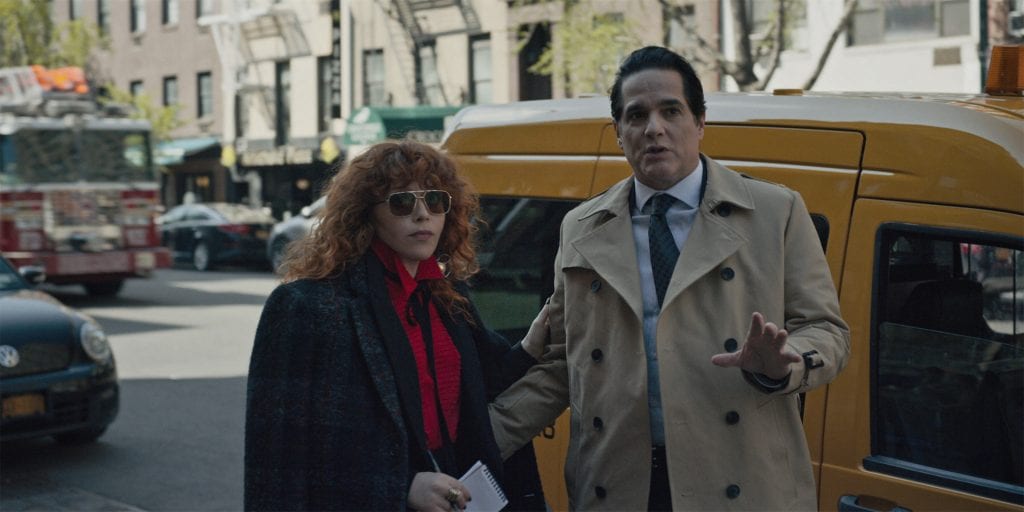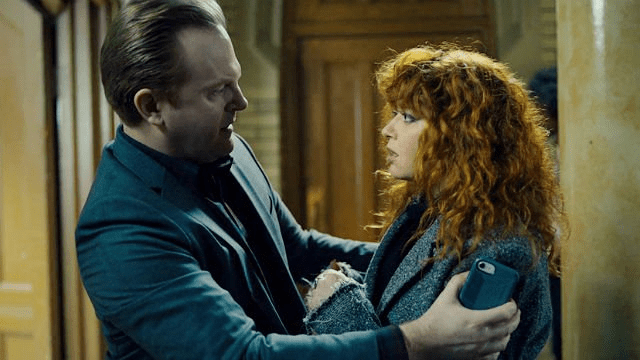Russian Doll could’ve ended with that final scene of Season 1 and it would’ve been perfectly satisfying. Nadia Vulvokov (Natasha Lyonne) found a way to overcome her issues to connect with people again. She even found her cat, Oatmeal.
It works really well as a single unit of storytelling. But there’s plenty of unfinished business to be dealt with over the course of the next two seasons. For one thing, there’s all those different Nadias in the final scene.
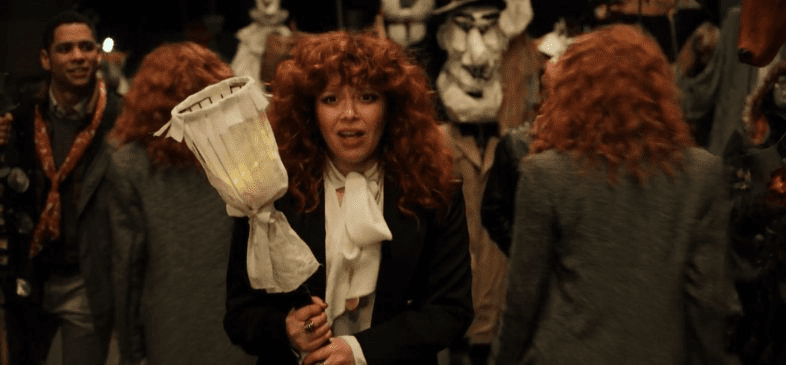
I know Netflix only renewed the show for Season 2 so far, but mark my words: there will be a third. Lyonne and director Leslye Headland are on record that Russian Doll was pitched as a three-season show. That’s enough for me to want to explore where the second and third seasons will go.
So that’s what I’m going to do.
If Season 1 was a video game, it’s a side-scroller
It’s been said that Russian Doll’s first season contains video game elements—such as constantly falling into pits and starting over at the beginning of the stage in Maxine’s bathroom—and I believe it. After all, Nadia is a video game programmer by trade. She was literally treating her time-looping situation like a programming problem. She kept looking for the glitch. I have zero problems using the video game metaphor for Russian Doll.
Season 1 was analogous with Nadia’s video game Ariadne. I’ve already made the case that the Season 1 plot follows the structure of the Greek myth of Theseus, Ariadne, and the Minotaur. But the mechanics of the season follow the other side of the Ariadne connection: Nadia’s game. And her game appears to work like a side-scroller:
- You begin at the start.
- You avoid enemies, traps, and pits, or you die.
- Then you start back at the beginning of the stage.
- With practice—by learning where all the pits and traps are—you beat the stage.
This sounds quite a bit like what we saw in Russian Doll, too, and is exemplified by games like Super Mario Bros.

The boss at the end of the stage is Nadia’s isolation, and it’s defeated by this existential realization: to join the world, Nadia needs to join in. She needs to accept help from people and she needs to actively help herself, as well as help others when she can.
It’s why she was able to find Oatmeal again; she cared enough to find her cat because she knew Oatmeal couldn’t do it alone.
Season 2 is a Metroidvania
Now that Nadia officially chose to reconnect with the world in Episode 8, she’s going to figure out her time-looping world isn’t behaving like a side-scroller with perfectly defined beginning and end points. She’ll start noticing it behaves like a Metroidvania, and yes, I’m going to explain what that means.
In a Metroidvania—named after the Metroid and Castlevania games that exemplify the format—you explore the world and acquire power-ups. Every new weapon and power-up you get makes you stronger, but it also allows you access to new areas that once looked to be dead ends. Jeremy Parrish of the Retronauts podcast says, “you always feel like you’re just not ready enough for the room you just entered, but you always get what you need for what’s around the new corner.” If that doesn’t sound like Nadia in Russian Doll, I don’t know what does.
Nadia doesn’t know if she should be in her time loops or not, but there’s no way back so she’ll figure out the new steps to take until she finds the new power-up that will get her out of there. She finds her way to Alan, then she finds her way to connecting with other people, and so on. And in her process, old dead ends will become mere barriers that she wasn’t powered up for earlier, and we’ll see Nadia’s world map get exponentially bigger.
Metroid and Mario look identical in structure in a simple screenshot, until you look at your ability to backtrack.
Nadia is already in a Metroidvania from the beginning of Russian Doll. Her first power-up was the scientific method, which she used to explore her time-looped world. It eventually opened the path that led to Alan and he gave her another power-up: perspective. That perspective led to her existential realization to want to participate in the world.
How was Alan able to give her that power-up? Because he’s on the same world map as her: the territory between trauma and acceptance.
It’s as metaphorical as they come, but this is what their world map looks like:
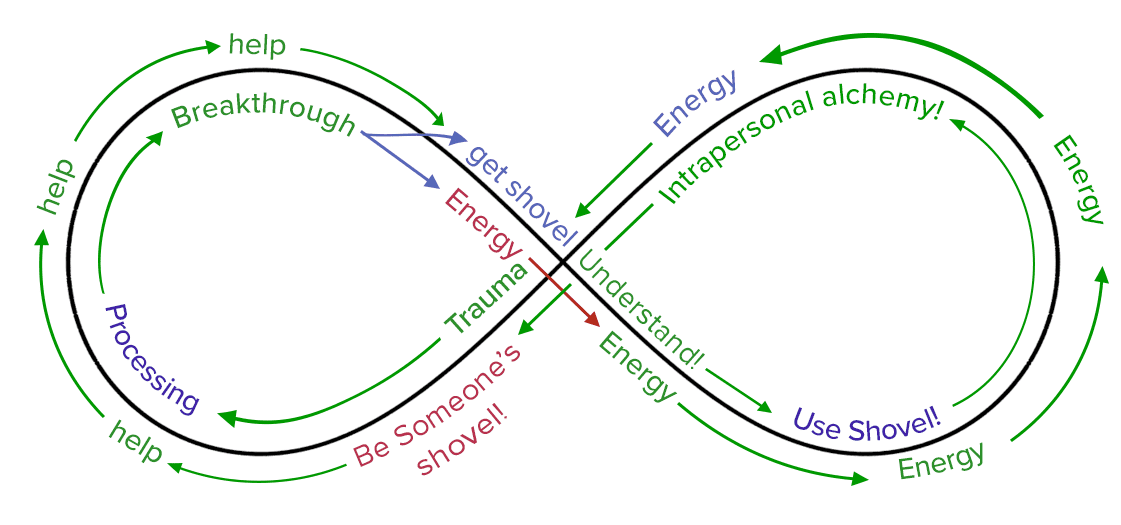
I made this diagram for my Twin Peaks work, but as it’s a trauma cycle, it matches up remarkably well with Nadia’s own path through trauma. Notice the diagram cycles around—not unlike Nadia’s time loops—and there are parallel loop paths on either side of the line.
One side of the infinity symbol involves experiencing trauma, processing the trauma, and then at a moment of breakthrough you are unable to process it so you cycle back around to the original trauma. It just keeps happening. Either Beatrice breaks your heart again or you’re sitting in front of a bathroom mirror at your 36th birthday party. You keep cycling back to your trauma, whether it’s revisiting it in memories or literally time-looping back to it.
The other side of the infinity symbol involves getting a golden shovel, choosing to use it, and then doing the work to dig yourself out of your shit and overcome your trauma. And then you help people when they need help with their digging. For this exploration of Russian Doll, substitute the word “shovel” with “Scientific Method,” then “Perspective.” Keep substituting power-ups into that part of the equation until Nadia is able to look her trauma in the eye instead of merely coughing up shards of glass. Only then, when she has enough power-ups in her repertoire, will Nadia be able to break through all the way from one side of the infinity loop to the other.
Nadia is overcoming trauma. She’s literally looping in time and she backtracks to her home base (her birthday party) with progressively more new skills.
When she walks into new areas where she’s pulling glass shards out of her mouth, these are areas Nadia’s not ready for yet. It’s exactly like walking into the molten hot areas in Super Metroid before you have the Varia Suit that can protect you from the extreme temperatures. Nadia needed to leave the situations with the shards until she is equipped to take on what’s below the surface.
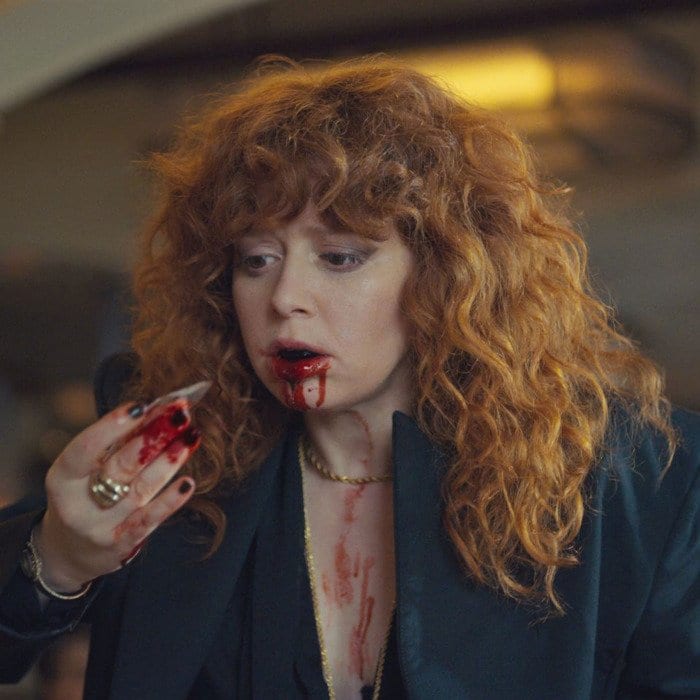
What dead ends are now pathways for Nadia?
As Nadia loops around, she’ll realize her old dead ends will yield more personal growth and she will have to conquer those aspects of her life. What dead ends are now open paths to explore now that Nadia’s actively trying to participate in the world?
Nadia’s still not able to take on the root trauma associated with the glass shards, but there is other imagery we’ve seen that should now be open for Nadia to explore.
In Season 1, the image of the labyrinth is what Nadia needed to overcome. Now that she understands how to accept and offer help, Seasons 2 and 3 can go into two large areas we’ve already seen.
Jewish Mysticism
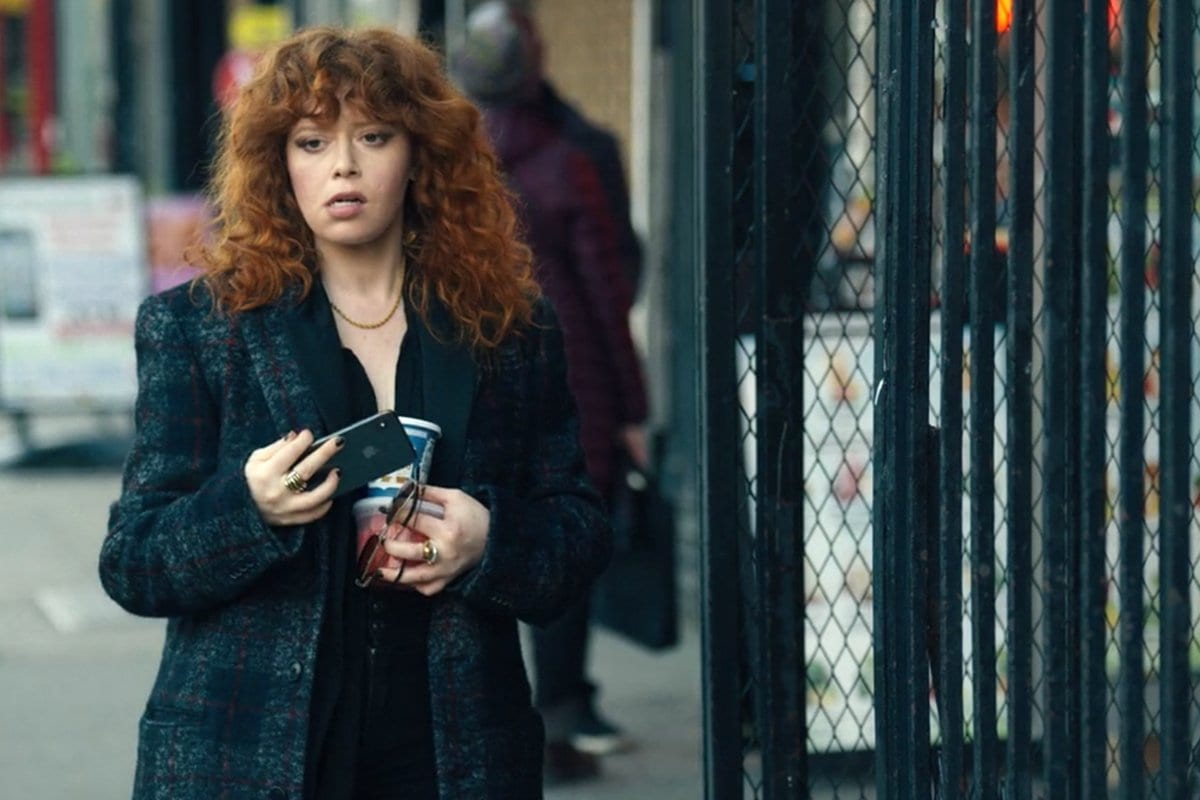
Nadia was looking into why her building—really, all the buildings important to her life—had a Jewish plaque on it. This investigation appeared to dry up and she moved on to looking into why Alan died that first time. I contest there’s more to dig into with Jewish Mysticism when she circles back to it.
For one thing, what we learned from this line of questioning in Season 1 was almost nothing. For another, Natasha Lyonne is heavily versed in studying the Talmud from an early age. There is no way Nadia can’t get a deeper understanding of herself by diving deeper into the mysticism in the coming episodes. I don’t know what it will yield, but it will happen.
Emily of New Moon
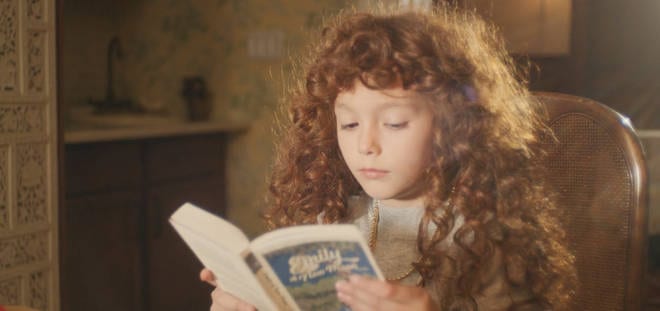
The book from Nadia’s youth seemed like a dead end after she kept dying when giving it to John’s daughter. It is a book Nadia dove deeply into as a child, but it has to be more important than just a step on Nadia’s path to connecting with others.
First of all it’s part of a trilogy, just as Russian Doll was originally pitched. Secondly, it’s something young Nadia used as a tool of avoidance. It was also a tool of protection from what she couldn’t process at the time, yes, but the byproduct of that self-protection is still avoidance of the truth.
I suspect the glass shards Nadia coughed up occurred because she shouldn’t be teaching another girl to hide from her situation like she did. Avoidance doesn’t seem to be the thing to teach, even when she’s trying to connect with the girl.
We’ll go back to Emily of New Moon as Russian Doll goes on, because it will take us further down the path into what she was hiding from.
Boss fights
Mother Issues
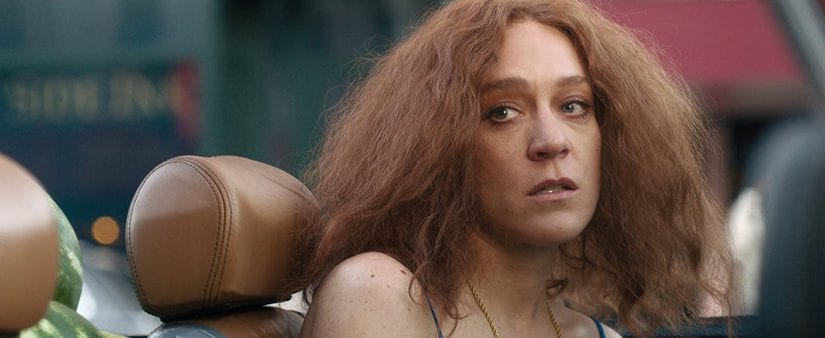
Issues with Nadia’s mother are obviously a huge part of Nadia’s trauma, but we still don’t know the particulars. There are clues about the glass shards, but why are they inside Nadia? Are they the trauma trying to escape? Are they a literal thing—a memory of putting the glass in her mouth as a child? There’s some ambiguity that can be clarified.
In an interview on NPR’s Fresh Air, Natasha Lyonne talked about how the watermelons was a real thing that happened, and that her own mother had mental problems. I know all the rotting fruit is supposed to be a signifier of timeline relativity, but does it also tie into the mother’s obsession with watermelons? There are so many unspoken areas for Nadia still to process. Lyonne has already had enough years of therapy to get enough perspective on what her mother was going through, so that she has let go of the anger and trauma, but Nadia has not.
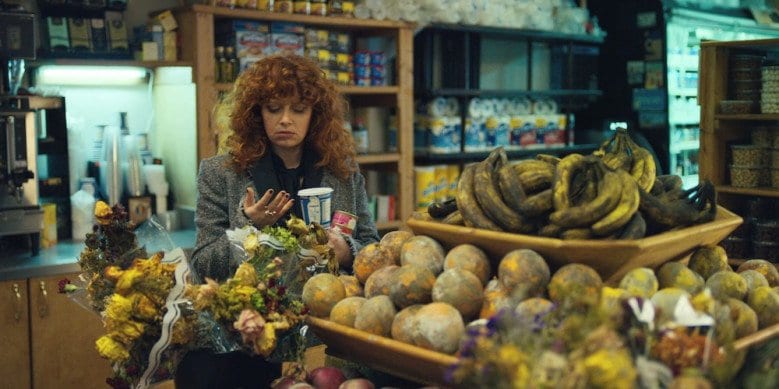
The biggest unsaid thing about Nadia’s mother is how she probably died at age 35 or 36. I highly suspect Nadia’s time loop crisis is brought on by Nadia having trouble accepting that she’s outlived her mother (or that she will soon). And she just can’t have that, so she keeps going back to her birthday party until she can accept this fact.
Father Issues
Nadia’s issues with her mother are obviously deep-seated. I am not contesting this one bit. Nadia’s been traumatized by interactions with her mother, but there is zero mention of her father at all.
We heard Nadia talk to Ruth about her mother, but we didn’t see her mother visually until the seventh episode after Nadia made the active choice to connect to people.
Her mother gradually became more real as the story went on. Yet we have heard absolutely nothing about her father. Is he merely absent? Or is something there she can’t even fathom talking about?
What we do know about are the unspoken daddy issues. Nadia has:
- Helped ruin John’s life by pursuing him even though he was married and with a family.

- Had a fling with Mike—who specifically says to Maxine “I’m a daddy” when she says she likes daddies—to start the whole show off.

- Almost had a fling with Alan, the night she was keeping an eye on him to discover why he died. Alan is not a father himself, but he has a rocky relationship with his own father.
There is something here and it will likely be something that comes to the surface in a big way, whether in Season 2 or 3. Who knows what shape the revelations will take, but there will be revelations.
Whatever the reason, Nadia’s father being an absence will be the power-up Nadia needs to make peace with her mother and her past. And once Nadia comes to terms with how she was raised, she’ll be able to stop looping back to her birthday party and break through to normal time again. This is the Final Boss of the show.
Nadia can finally finish growing up beyond her trauma, or at least she can decide that her birth—and therefore life—has proper value and is worth being celebrated.


